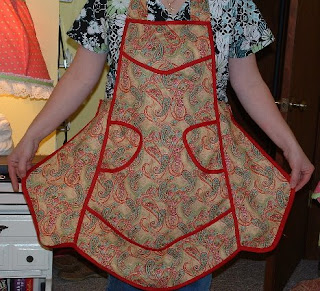This is my first attempt at growing potatoes. I've searched online for different ways to grow them. Old tires leak toxins into the soil, so that was not an option. Barrels seemed interesting; however, I would have to go out and buy one. I'm trying to be green and thrifty. Then I came across a site about growing them in trash cans. Brillant! I thought to myself. I have two plastic 30 gallon trash cans sitting in my greenhouse not being used. I drug them out to my husband's workshop, and started drilling 5/8 holes in the bottoms. I also drilled holes 6" up from the bottom. I've read that it's real important that potatoes have good drainage so they won't rot.

I then mixed top soil, manure, and 1 cup of 13/13/13 fertilizer, and filled the can 1/3 the way up.

Then I quartered my red potatoes around the eyes, and placed them eye up on the soil mixture in the can. I covered them with about 3 to 4 inches of soil.

After I planted them, I watered them from my rain barrels. I placed them in my green house for right now. We are expecting rain for the next 3 to 4 days, and I didn't want them to get too much water at first and rot. Once this front passes then I'll drag them back outside and water them as need be.

In addition to planting red potatoes, I also planted radishes and carrots. I've been reading "The Container Gardener's Bible," and I'm going to try growing veggies in containers this year. I've not had much success with root vegtables in this red Georgia clay soil, so this year I'm going to try growing them in containers.
 This is the first day in 4 days that we've seen the sun. I'm not complaining too much, because we've been in a drought for about 2 years now. This is my romaine that I've planted in a pot. It's doing quite nicely.
This is the first day in 4 days that we've seen the sun. I'm not complaining too much, because we've been in a drought for about 2 years now. This is my romaine that I've planted in a pot. It's doing quite nicely.  Here is my solar dryer. (LOL) I love the smell of sheets that have been hung out on the line. This really cuts down on the electric bill.
Here is my solar dryer. (LOL) I love the smell of sheets that have been hung out on the line. This really cuts down on the electric bill.  Here is my herbs. I'm growning lemon balm, mint, and lavender. However, the lavender isn't doing so well. I love to make tea with the lemon balm and mint. That's why they aren't as big as they should be. I've been cutting on them. :0)
Here is my herbs. I'm growning lemon balm, mint, and lavender. However, the lavender isn't doing so well. I love to make tea with the lemon balm and mint. That's why they aren't as big as they should be. I've been cutting on them. :0)

 This is apron (A) Smock Pocket. I made this for St. Patrick's Day. This again is a real simple pattern to sew from. I love the waist band on this apron. I had bought the green checkered material on sale at Walmart for $1 yrd. At the time it seemed like a bargin. But the material was thin, and it made it difficult to sew at times. The shamrock material was cotton and thicker. Next time I'll buy thicker material when sewing this apron.
This is apron (A) Smock Pocket. I made this for St. Patrick's Day. This again is a real simple pattern to sew from. I love the waist band on this apron. I had bought the green checkered material on sale at Walmart for $1 yrd. At the time it seemed like a bargin. But the material was thin, and it made it difficult to sew at times. The shamrock material was cotton and thicker. Next time I'll buy thicker material when sewing this apron.  I bought this book a while back, and I love it. It has a lot of neat apron designs. I love the fabrics they use for some of their aprons. It really inspires you to sew. :0)
I bought this book a while back, and I love it. It has a lot of neat apron designs. I love the fabrics they use for some of their aprons. It really inspires you to sew. :0)









 In addition to planting red potatoes, I also planted radishes and carrots. I've been reading "The Container Gardener's Bible," and I'm going to try growing veggies in containers this year. I've not had much success with root vegtables in this red Georgia clay soil, so this year I'm going to try growing them in containers.
In addition to planting red potatoes, I also planted radishes and carrots. I've been reading "The Container Gardener's Bible," and I'm going to try growing veggies in containers this year. I've not had much success with root vegtables in this red Georgia clay soil, so this year I'm going to try growing them in containers.